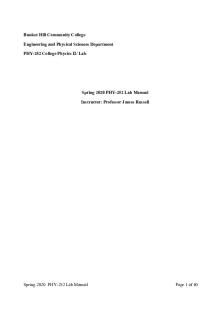Thermocouple Lab Manual Artemis Ma PDF

| Title | Thermocouple Lab Manual Artemis Ma |
|---|---|
| Author | Artemis Ma |
| Course | Basic Mechanical Measurements Laboratory |
| Institution | University of Minnesota, Twin Cities |
| Pages | 4 |
| File Size | 280.8 KB |
| File Type | |
| Total Downloads | 60 |
| Total Views | 134 |
Summary
Download Thermocouple Lab Manual Artemis Ma PDF
Description
UNIVERSITY OF MINNESOTA Mechanical Engineering ME 4031W
K-type Thermocouple Time Response Lab Manual Artemis Ma(ID: 4813358) Lab Section: 16 (TA: Manikandan Suresh) Specific Comments:
Examples of Effective Writing:
Suggestions for Improvement:
Additional Comments:
1. Introduction This document describes an outline of procedures to setup a thermocouple and a DAQ to measure temperature in Celsius, using a LabView virtual instrument. A thermocouple measures the temperature difference b
2. Hardware Guide & Set-Up Table 1. List of Equipment Materials/Equipment DAQ Digital Multimeter (DMM) Op-Amp Thermocouple Ice Water Bath
Type USB-6001 Keithley 2700 Gain of 100 K3
Uncertainty ± 6 mV [1] 0.0015% [2] – ± 2.2 °C [3] –
Figure 1: Schematic diagram of the thermocouple circuit[3] 1. Calibrating the Op-Amp: i Plug the op-amp to a power outlet and let it warm up for 15 minutes. ii Short the input sockets iii Connect the output sockets to the Keithley 2700 DMM. Adjust the potentiometer knob on the op-amp until the output reads close to zero [V]. 2. Setting up for measurement: i Connect the K-type thermocouple to the Op-Amp input with alligator clamp wires ii Set up the reference environments for the thermocouple. (For example, to measure room temperature, submerge the measuring tip of the thermocouple into the ice bath, leaving the reference ends in air) iii Connect the Op-Amp output to the DAQ (Vout- to Ai0+, and Vout- to the Ai0) iv Connect the DAQ to the Computer using the USB cable provided with the DAQ v Follow the LabView VI Guide
3. LabView VI Guide:
Figure 2: Screenshot of the LabView VI front panel 1. Create a csv file. This will be where the measurement data outputs to. 2. In the front panel of the VI, click on the folder icon and navigate to the csv file. 3. Input the DAQ measurement parameters into their respective boxes (“Rate [HZ]” as in rate of data collection, “number of samples” as in how many samples the DAQ would group into one data point) 4. Now you can click “run” on the top left to start measuring and recording of the temperature difference between the tip of thermocouple and the reference ends. 5. To correctly measure the temperature response, you can monitor the recordings in real-time with the waveform graph window. If measuring a stable temperature, the waveform may seem noisy. This is due to the autoscaling of the graph and not representative of the precision. 6. Press “stop” to stop recording
4. Troubleshooting Guide o If the temperature measurement remains around zero, the reference tips of the thermocouple that were submerged in ice water might be touching the metal container, therefore shorting the thermocouple. Adjust the set-up to resolve. o If the temperature reading is not zero when it should be, the op-amp might be producing an offset. Recalibrate the op-amp to resolve. o If the temperature reading appears to be the negative value of what it should be, switch the leads from the thermocouple going into the Op-Amp inputs to resolve.
References [1]
National Instruments. (2014). USB 6001 DAQ; Specifications. Retrieved from http://www.ni.com/pdf/manuals/374369a.pdf [2] Keithley. (2016). Digital Multimeter; Specifications. Retrieved from https://www.tek.com/datasheet/2700-multimeter-data-acquisition-switchsystems/integraseries-technical-data-sheet [3] Lab 1a LabView: Thermocouple Time Response...
Similar Free PDFs

Tutorial Artemis
- 17 Pages

Type-J Thermocouple Chart
- 3 Pages

Poseidon and Artemis
- 3 Pages

Artemis - Lecture notes 13
- 2 Pages

Module 7 - Artemis & Apollo
- 12 Pages

Outline for Artemis
- 4 Pages

Aphrodite and Artemis
- 5 Pages

CN-Lab-Manual - Full Lab Manual
- 34 Pages

Lab manual
- 49 Pages

Lab Manual
- 60 Pages

IMH-LAB- Manual manual manual
- 21 Pages

ECE235 Lab Manual lab work
- 53 Pages

DLD LAB 1 - Lab manual
- 7 Pages

LAB Fisica 4 - Manual lab
- 58 Pages
Popular Institutions
- Tinajero National High School - Annex
- Politeknik Caltex Riau
- Yokohama City University
- SGT University
- University of Al-Qadisiyah
- Divine Word College of Vigan
- Techniek College Rotterdam
- Universidade de Santiago
- Universiti Teknologi MARA Cawangan Johor Kampus Pasir Gudang
- Poltekkes Kemenkes Yogyakarta
- Baguio City National High School
- Colegio san marcos
- preparatoria uno
- Centro de Bachillerato Tecnológico Industrial y de Servicios No. 107
- Dalian Maritime University
- Quang Trung Secondary School
- Colegio Tecnológico en Informática
- Corporación Regional de Educación Superior
- Grupo CEDVA
- Dar Al Uloom University
- Centro de Estudios Preuniversitarios de la Universidad Nacional de Ingeniería
- 上智大学
- Aakash International School, Nuna Majara
- San Felipe Neri Catholic School
- Kang Chiao International School - New Taipei City
- Misamis Occidental National High School
- Institución Educativa Escuela Normal Juan Ladrilleros
- Kolehiyo ng Pantukan
- Batanes State College
- Instituto Continental
- Sekolah Menengah Kejuruan Kesehatan Kaltara (Tarakan)
- Colegio de La Inmaculada Concepcion - Cebu

